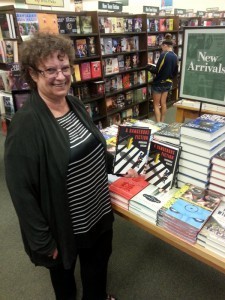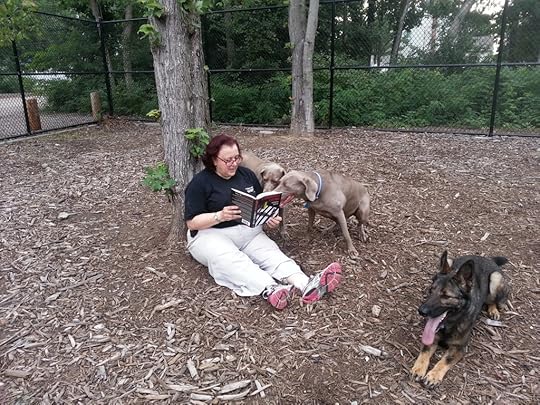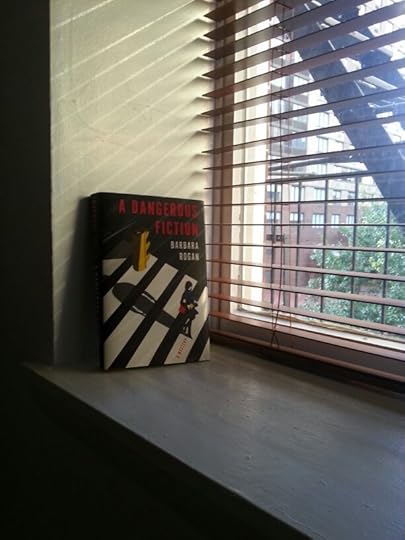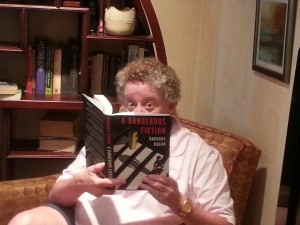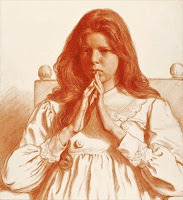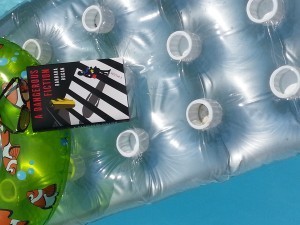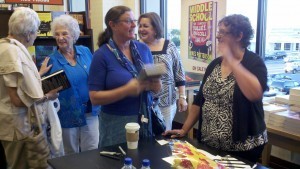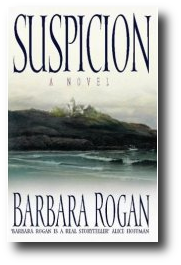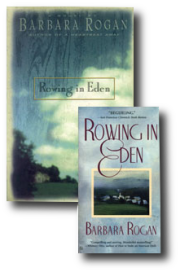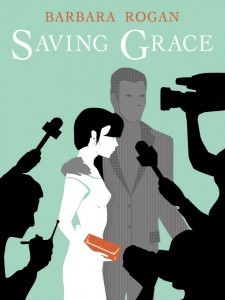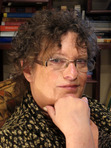Barbara Rogan's Blog, page 5
October 1, 2013
Looking For Friends In All the Wrong Places
 Send to Kindle
Send to Kindle
In a recent interview with Publishers Weekly, Claire Messud was asked a question about her novel, THE WOMAN UPSTAIRS, that she didn’t like. Would you, the interviewer asked, want to be friends with your protagonist, Nora?
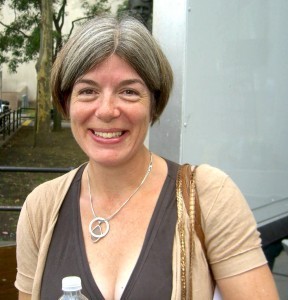 Messud exploded. “For heaven’s sake, what kind of question is that? Would you want to be friends with Mickey Sabbath? Saleem Sinai? Hamlet? Krapp? Oedipus? Oscar Wao? Antigone? Raskolnikov? … If you’re reading to find friends, you’re in deep trouble. We read to find life, in all its possibilities. The relevant question isn’t ‘is this a potential friend for me?’ but ‘is this character alive?’”
Messud exploded. “For heaven’s sake, what kind of question is that? Would you want to be friends with Mickey Sabbath? Saleem Sinai? Hamlet? Krapp? Oedipus? Oscar Wao? Antigone? Raskolnikov? … If you’re reading to find friends, you’re in deep trouble. We read to find life, in all its possibilities. The relevant question isn’t ‘is this a potential friend for me?’ but ‘is this character alive?’”
Reactions followed swiftly. A panel of writers was assembled by the New Yorker and asked to weigh in on the issues raised by Messud’s comments. Let us assume that the tactful tone of their opinions was uninfluenced by the fact that Messud’s husband, James Wood, is the literary critic for the New Yorker. Jonathan Franzen’s admirably brief remarks began, “I hate the concept of likability,” which will come as no shock to those who remember Franzen declining Oprah Winfrey’s endorsement on the grounds that her viewers were not the right readers for his book.
Margaret Atwood allied herself firmly with Claire Messud. “Intelligent readers do not confuse the quality of a book with the moral rectitude of the characters.… We love to watch bad people do awful things in fictions, that we would not like if they did those things to us in real life. The energy that drives any fictional plot comes from the darker forces, whether they be external (opponents of the heroine or hero) or internal (components of their selves).”
Donald Antrim seemed to suggest that concern over a character’s likeability arises from the author’s personal insecurity and need for approval. “The author maneuvering for love is commonplace and ordinary, and the work of fiction that seductively asserts the brilliance or importance or easy affability of its creator is an insubstantial thing. I have no problem with liking a character. But if that’s the reason I’m reading, I’ll put the book down.”
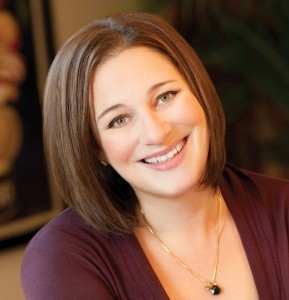 Next, in an article on Slate, best-selling author Jennifer Weiner weighed in on the side of likability, as one whose characters are often accused of same. She delivered short, devastating critiques of Messud’s latest novel and a memoir by Donald Antrim, along with a cringe-making quote from another Messud interview. “Don’t go around asking the question, ‘Is this character likable?’ and expect that to be compatible with serious literary endeavors,” Messud declared. “That’s not what it’s about. If you want self-help that’s going to make you feel good, or you want the Ya Ya sisterhood, fantastic, that’s a great thing to read, I have no complaints about that. But it’s not compatible with serious endeavor.” Weiner went on to deconstruct these words as “the latest code employed by literary authors to tell their best-selling brethren that their work sucks.”
Next, in an article on Slate, best-selling author Jennifer Weiner weighed in on the side of likability, as one whose characters are often accused of same. She delivered short, devastating critiques of Messud’s latest novel and a memoir by Donald Antrim, along with a cringe-making quote from another Messud interview. “Don’t go around asking the question, ‘Is this character likable?’ and expect that to be compatible with serious literary endeavors,” Messud declared. “That’s not what it’s about. If you want self-help that’s going to make you feel good, or you want the Ya Ya sisterhood, fantastic, that’s a great thing to read, I have no complaints about that. But it’s not compatible with serious endeavor.” Weiner went on to deconstruct these words as “the latest code employed by literary authors to tell their best-selling brethren that their work sucks.”
 Her argument is against what she calls the “imagined popular/literary dichotomy.” The dismissive attitude of some female literary writers toward their more commercial sisters is not only pompous and self-aggrandizing, it also distracts from the real problems women writers face getting critical attention and respect. When publishers adopt the same attitude, the result is a narrowing of the field for all writers. “Authors are placed on one side or another of that pop/lit divide, and prohibited from using all the crayons in the box. They’re stuck with their particular color palette: pretty pastels if they write commercial fiction, and darker browns and grays to be considered literature.”
Her argument is against what she calls the “imagined popular/literary dichotomy.” The dismissive attitude of some female literary writers toward their more commercial sisters is not only pompous and self-aggrandizing, it also distracts from the real problems women writers face getting critical attention and respect. When publishers adopt the same attitude, the result is a narrowing of the field for all writers. “Authors are placed on one side or another of that pop/lit divide, and prohibited from using all the crayons in the box. They’re stuck with their particular color palette: pretty pastels if they write commercial fiction, and darker browns and grays to be considered literature.”
So where do I stand on all this? With one foot firmly in each camp, as it happens.
I agree with Weiner about the fallacy of the commercial/literary divide. My own books have been categorized variously as literary fiction, women’s fiction, and mystery. Those labels don’t define me as a writer; they’re just publishing shorthand for the convenience of booksellers and reviewers. Those of my novels critics deemed “literary fiction” are no better written than the ones called mysteries. A poet is no less a poet for experimenting with different forms. Neither is a novelist. There is no dichotomy between literature and popular fiction; rather, there is a continuum calibrated not by genre but by the quality of the writing.
 On the other hand, I agree with Messud and Atwood that the demand of some readers for likable characters is problematic for writers with a harder edge. I found Gillian Flynn’s GONE, GIRL to be a brilliantly crafted novel and totally compelling read. It sold like hotcakes, too, so millions of people must have agreed with this assessment. But on Goodreads and many other online forums, one criticism came up with surprising frequency: “I didn’t like any of the characters.” Well, duh! Flynn’s protagonist was a psychopath, the equivalent of a Tom Ripley. So was Ron Rash’s Serena, who for pure evil could spit in the eye of Hannibal Lector. You’re not supposed to like such characters; you’re supposed to watch in fascinated horror as they operate. Their difference from us—rule-abiding, housebroken, socialized us—is sort of the point of books like that.
On the other hand, I agree with Messud and Atwood that the demand of some readers for likable characters is problematic for writers with a harder edge. I found Gillian Flynn’s GONE, GIRL to be a brilliantly crafted novel and totally compelling read. It sold like hotcakes, too, so millions of people must have agreed with this assessment. But on Goodreads and many other online forums, one criticism came up with surprising frequency: “I didn’t like any of the characters.” Well, duh! Flynn’s protagonist was a psychopath, the equivalent of a Tom Ripley. So was Ron Rash’s Serena, who for pure evil could spit in the eye of Hannibal Lector. You’re not supposed to like such characters; you’re supposed to watch in fascinated horror as they operate. Their difference from us—rule-abiding, housebroken, socialized us—is sort of the point of books like that.
But there are all sorts of books, and it’s nonsense to say that great literature is incompatible with likable characters. Elizabeth Bennett, anyone? Jo March? The Glass family? It takes a jaundiced soul to dismiss a protagonist like Huck Finn on the grounds of excessive likability.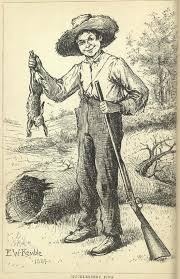
It also disturbs me when writers instruct readers on how to read. Readers and writers occupy separate spheres. Reading and interpreting is the reader’s domain, writing is the author’s. As much as I appreciate my readers and value their feedback, I follow my own muse while writing. Writers who don’t want to be told what to write or how to write it should extend the same courtesy to readers, including reviewers and interviewers.
As it happens, I was interviewed by Publishers Weekly about my novel, A DANGEROUS FICTION, within a week or so of Messud’s interview. The questions were not, perhaps, what I would have chosen, but unless we go around interviewing ourselves, they never are. I answered courteously and as thoughtfully as I could, which I’ve always seen as part of the job. I could be wrong—snarkiness gets more attention—but it’s my own form of noblesse oblige.
Finally, I would respectfully suggest that it’s better to let others praise one’s work as a “serious literary endeavor” than to do so oneself.
Thanks for reading! I post on my own irregular schedule, so the best way to stay up to date is to subscribe to the blog via RSS feed or email—links to the left.
Also, I’m delighted to announce that A DANGEROUS FICTION is now available on Audible.com.
September 16, 2013
Cementing the Goal Posts
 Send to Kindle
Send to Kindle
Writing is a rigged game in which the goal posts recede as you approach them.
 At first, the deepest desire of the writer’s heart is to find an agent, the necessary first step toward finding a publisher. No sooner is that achieved than the real goal presents itself: selling the book. It takes an agonizing while before that happens, but assuming it does, the writer has barely downed that first celebratory glass of Champagne before she realizes that selling the book to a publisher is just the first step in selling it to the reader. Getting read is the real goal, the writer realizes, but for that to happen, the book must be discovered by reviewers.
At first, the deepest desire of the writer’s heart is to find an agent, the necessary first step toward finding a publisher. No sooner is that achieved than the real goal presents itself: selling the book. It takes an agonizing while before that happens, but assuming it does, the writer has barely downed that first celebratory glass of Champagne before she realizes that selling the book to a publisher is just the first step in selling it to the reader. Getting read is the real goal, the writer realizes, but for that to happen, the book must be discovered by reviewers.
The first review is a wonderful thing. Someone has taken the book seriously enough to write about it. The writer realizes that the book now has an existence of its own, separate from its progenitor. Soon, though, those elusive goal posts slip backwards. It’s all very well that Publishers Weekly liked the book, the writer thinks, but what about the New York Times? The New Yorker? People Magazine? And if the book is reviewed, where is it reviewed? Does it make the front page, or is it buried in a column somewhere?
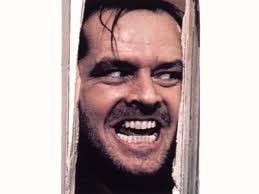 Then there are sales. In the past, writers had no way of gauging them except through publishers’ semi-annual royalty reports. Now they can track their relative standing via Amazon’s rankings, which are updated hourly: a wonderful trap for obsessive authors. Whatever his ranking, the writer aspires to rise higher. Thus writers conspire with the world to drive themselves mad.
Then there are sales. In the past, writers had no way of gauging them except through publishers’ semi-annual royalty reports. Now they can track their relative standing via Amazon’s rankings, which are updated hourly: a wonderful trap for obsessive authors. Whatever his ranking, the writer aspires to rise higher. Thus writers conspire with the world to drive themselves mad.
Enough, I say. Time to stop and smell the roses. Time to look around and say in the words of the late great Kurt Vonnegut, “If this isn’t great, what is?”
So today’s post is all about having fun and celebrating what is, instead of fretting about what could or should happen. This is good for the book as well as the writer. Once it’s launched, the book is all grown up now, out in the world and fending for itself. It doesn’t need its author breathing down its back and monitoring its every step.
Here’s what I’m celebrating right now: NPR station WSHU reviewed A DANGEROUS FICTION. The reviewer was Joan Baum, who enjoyed it thoroughly and recorded this wonderful piece. Hearing my work reviewed on the station I listen to every day has long been a long-time dream of mine, and this time, I’m holding fast to those goal posts.
Lots of other critics have written wonderful reviews. A few called it “the best mystery of the year.” More cause for celebration.
Readers have written to tell me that after reading A DANGEROUS FICTION, they’re going back to read all my previous work. There are no sweeter words to whisper in a writer’s ear than those. Others ask about a sequel–and I’m writing one.
With shelf space shrinking, many published books don’t make it into bookstores. Seven weeks after publication, A DANGEROUS FICTION is still out there. How can I not be grateful for that?
I’m not sure where I rank on Amazon. I’ve quit checking. But I do know that the book is the #1 choice for story hour in dog parks.
Babies love it, too.
The story’s set in NYC and feels at home there. Here it is, in noir mode, keeping a lonely vigil over the mean streets of the city.
Exhausted by the rigors of self-promotion, A DANGEROUS FICTION was recently spotted taking a break.
Fair warning, though: A DANGEROUS FICTION is not for scaredy cats. This reader’s hair was black when she started the book.
What about you? I know you have unmet goals, too; we all do. But let’s put them aside for once. Tell me about how far you’ve come, what you’re proud of, and what you’ve accomplished already.
September 9, 2013
The Inside Scoop: A Publicist’s Take on Book Marketing
 Send to Kindle
Send to Kindle
No one writes for his desk drawer. Books are a means of transmitting stories, ideas, history, experience, and emotion; and that transmission can only succeed when the books are read. But to be read they must first be discovered by readers, and therein lies the rub. Books need publicity the way lungs need oxygen, but with so many competing for attention, how can writers attain their moment in the sun?
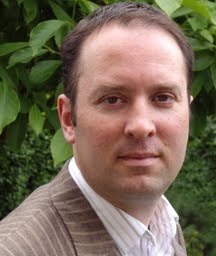 Recently I had the chance to pick the brains of Ben Cameron, founder of the London-based Cameron Publicity and Marketing. (Rather a violent metaphor, when you think about it, but I promise no publicists were injured in the production of this post.) We talked about what sells books, how writers can help (and hurt) themselves, the role of independent publicists and what to watch out for, and much more. Have a read, then tell me what you think.
Recently I had the chance to pick the brains of Ben Cameron, founder of the London-based Cameron Publicity and Marketing. (Rather a violent metaphor, when you think about it, but I promise no publicists were injured in the production of this post.) We talked about what sells books, how writers can help (and hurt) themselves, the role of independent publicists and what to watch out for, and much more. Have a read, then tell me what you think.
Barbara: Tell me a bit about yourself and your company. What made you decide to focus on publicity and marketing for books?
Ben: I always loved books so when I finished university in the US and moved to the UK 20 years ago it was always my intention to work in publishing in some way. My first job in the industry was with a book wholesaler and it was there that I discovered marketing and publicity – I love the strategy and to creatively think my way around problems (marketing), and I’m a pretty decent talker (publicity). I was there for a few years before moving to a publishing company and then setting up my own agency.
Barbara: Once, at a publishing party, I heard one well-known publisher admit that he really had no idea what sells books, while others at the table nodded. Do you know? Has anyone studied the question?
Ben: Great question! There is no one answer. What we do is push books toward people and push people toward books and to a large degree we can influence sales. But for a big seller there is also an element of luck and magic that has to happen. The spark that made Harry Potter a phenomenon was awards, a marketing and publicity thing, but there was also a kindling of goodwill and great writing that needed to be there as well. Why did 50 Shades of Grey become a hit? I have no idea – erotica was certainly nothing new but it seems like its time had come and that book was in the right place at the right time. It was lucky, but a publicist did get it in the position that it needed to be in to become THAT book.
Barbara: Can you give an example of a publicity/marketing campaign that elevated a previously unknown or little-known writer to the bestseller lists? What do you think made it so successful?
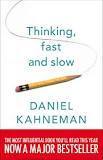 Ben: A good example is the book Thinking, Fast and Slow by Daniel Kahneman. It is a big publisher book (Penguin) but an interesting example of how to position a book for the market. This is a very academic psychology book that was promoted as popular science/business like Freakonomics or Malcolm Gladwell books. There were great little examples and excerpts from the book that were used for publicity to get it into the media in places that would not normally be interested in such and an in-depth and difficult to read book. A lot of what publicists do is to emphasize the more popular aspects of a book.
Ben: A good example is the book Thinking, Fast and Slow by Daniel Kahneman. It is a big publisher book (Penguin) but an interesting example of how to position a book for the market. This is a very academic psychology book that was promoted as popular science/business like Freakonomics or Malcolm Gladwell books. There were great little examples and excerpts from the book that were used for publicity to get it into the media in places that would not normally be interested in such and an in-depth and difficult to read book. A lot of what publicists do is to emphasize the more popular aspects of a book.
Barbara: Effective publicity services don’t come cheap. Are they a good investment for all writers? If not, what sort of writer should consider hiring a publicity and/or marketing firm?
Ben: They aren’t cheap because it takes a huge amount of time and finesse to run an effective publicity campaign. A very academic book or a poetry book, for example, is not going to benefit much from a campaign – there just aren’t enough media outlets that will cover them – while something that can capture the imagination of a wide audience can pay back the cost many times over. Genre fiction is great for a shorter campaign, say 4-6 weeks, as that is enough time to reach its audience. Non-fiction often suits a longer campaign depending on the author and topic. The important thing is to have a publicist explain why they think a certain style of campaign will suit the book and to feel comfortable with that explanation.
Barbara: Your company represents both published and self-published writers. Are there barriers to self-published writers getting reviews and coverage in mainstream media? If so, how do you overcome or sidestep them?
 Ben: Yes, there are barriers but they are getting less significant every day. Getting reviews in the big newspapers is almost impossible still for obviously self-published books, but a lot of self-published books actually slip past the gatekeepers because they look as good as books from traditional publishers. To my mind feature articles and interviews are much more important than reviews anyway, and the journalists who do them care less about where a book came from than telling a good story. Most media understand that they need to include self-published books now but have difficulty knowing which books are worth consideration. That is where a good publicity pitch can go a long way.
Ben: Yes, there are barriers but they are getting less significant every day. Getting reviews in the big newspapers is almost impossible still for obviously self-published books, but a lot of self-published books actually slip past the gatekeepers because they look as good as books from traditional publishers. To my mind feature articles and interviews are much more important than reviews anyway, and the journalists who do them care less about where a book came from than telling a good story. Most media understand that they need to include self-published books now but have difficulty knowing which books are worth consideration. That is where a good publicity pitch can go a long way.
Barbara: Has the consolidation of retail outlets (i.e. Amazon) affected your publicity and marketing strategy, and if so, how?
Ben: It isn’t good in many ways, but Amazon has been great for marketing. A customer can read about a book and instantly purchase it online. That is incredibly powerful for sales. Ebooks play into that as well – I myself will often read a review, buy the book immediately on my Kindle and start reading it within a minute. All that said, I personally love nothing more than going through the shelves in a good bookshop and placement of bookshops and bookshop events are helpful as well.
Barbara: What are the most effective ways for writers, both published and self-published, to help their own books and careers?
Ben: If you can afford a campaign it can really give you a long-term boost, but if not you can also buy-in the tools that you need to do the job yourself. You can pay only for a professionally written press release or a media mailing list or a listing on NetGalley (a website that showcases books to journalists, bloggers and reviewers) and it won’t cost an arm and a leg.
Barbara: What are the biggest mistakes you see writers make in promoting their own work?
 Ben: Not following up. Just sending out emails, review copies of books or press releases will get you almost nowhere. There needs to be a proper sales pitch made to the journalist explaining, in no uncertain terms, why the book is important. The author needs to be persistent and not get discouraged if they get no initial response. It takes a lot of time and effort and many people give up before they have really made the case for their book.
Ben: Not following up. Just sending out emails, review copies of books or press releases will get you almost nowhere. There needs to be a proper sales pitch made to the journalist explaining, in no uncertain terms, why the book is important. The author needs to be persistent and not get discouraged if they get no initial response. It takes a lot of time and effort and many people give up before they have really made the case for their book.
Barbara: A great many publicity and marketing services have sprung up to service the boom in self-published books, and some of them seem sketchy to me, offering expensive services that are unlikely to prove effective. What questions should writers ask prospective service providers? What should they beware of?
Ben: Like every part of self-publishing, the sharks are out there and there are plenty of poor services on offer. Do your research, talk to someone at the company or meet them in person and make sure that you are comfortable that they understand you and you book. Be wary of anyone who “guarantees” results – those results may well be on their own blog or podcast with very little audience, and publicity just doesn’t work in that way. Go for experience, a campaign designed specifically for you, a company that will regularly give you feedback and someone who “gets” your book.
Many thanks to Ben Cameron for sharing his time and expertise with IN COLD INK. He can be reached on Facebook and on Twitter at @CameronPMtweets .
You might also enjoy these interviews with leading literary agent Gail Hochman, Simon & Schuster publisher Marysue Rucci, and publishing specialist Elizabeth Lyon. There are lots more to come, too, so do consider subscribing to IN COLD INK through links on the right.
September 1, 2013
Cafe Nevo Revisited
 Send to Kindle
Send to KindleWhen published books are reissued, it’s unusual to get any critical attention at all, so I was thrilled when I learned that Ellis Shuman recently reviewed CAFE NEVO for “The Times of Israel.” I think I enjoyed his review as much as he enjoyed the book–so much so that, with his kind permission, I am sharing it with you today.
A little background first. CAFE NEVO was my second published novel, and to this day, it remains my family’s favorite; not just theirs, either. Among the writers who were kind enough to praise the book were Alan Silitoe, author of THE LONELINESS OF THE LONG DISTANCE RUNNER, who wrote: “Wonderfully vivid and well-constructed…I couldn’t put it down. Barbara Rogan is that rare writer who creates equally credible male and female writers; a great talent for the souls of people, which is what writing novels is all about.” Madeleine L’Engle called it “a wonderful novel, with richly developed characters acting and interacting… the café and its clients will long remain in memory.” And Alice Hoffman said, “From the very first line of CAFÉ NEVO we are in the hands of a real storyteller. Barbara Rogan writes with compelling grace.”
Throughout my writing career I’ve been blessed with some wonderful reviews, but the critical response to CAFE NEVO was something special. Here’s a small sample:
“An inspired, passionate work of fiction…a near-magical novel.”—Kirkus Review
“A wonderful novel … vivid … unforgettable.”—San Francisco Chronicle
“Fresh, funny, tragic, violent, sexy, mystical and romantic…Barbara Rogan’s style is utterly engaging…works beautifully.”—Christian Science Monitor
CAFE NEVO, originally published by Atheneum and New American Library, was out of print for a long time until my friends at E-Reads brought it back into the world in a brand-new ebook and paperback edition two months ago. To me it feels as if not only the book has been resurrected, but also its characters: Emmanuel Yehoshua Sternholz, the waiter and proprietor of Cafe Nevo, and its other cantankerous, argumentative, but brilliant habituees. I love these characters dearly, and I’m so glad that new generations of readers will now have the chance to discover them. I know that there are endless new books coming out, clamoring for attention, and rightly so. But I’m hoping that readers who know my work will make some time for CAFE NEVO.
Ellis Shuman has this and a number of other reviews and posts on his interesting blog; I encourage you to check it out for yourselves. Here is his review of CAFE NEVO:
“The Aroma of Tel Aviv’s Coffee House Culture

I am writing these lines on my laptop as I sip my morning cappuccino. Like many who work in Ramat Gan’s Bursa district, my day begins with a cup of steaming hot coffee professionally prepared; there are many coffee shops and cafes in the neighborhood. Some people linger over their coffee, catching up on iPhone messages and answering emails; while others, like me, pull out their laptops and type away, undisturbed by the grinding of coffee beans; the hiss of steam escaping as milk is heated; and the swish of credit cards as orders are recorded.
Go back twenty five years. The fictitious Café Nevo of the Barbara Rogan novel of the same name is the “oldest and certainly the grungiest of the Dizengoff cafés”. The coffee shop, originally established by two enterprising Polish brothers, attracts not only common workers, but “writers, actors, and artists who by virtue of their socialist ideology styled themselves members of the proletariat, but who in fact constituted the Tel Aviv elite of their day”.
“If they were that good they’d be working,” one of the characters of the novel says of Café Nevo’s clientele. “Nobody with any serious work to do hangs out in cafés”.
Quirky and colorful regulars
Café Nevo has quirky and colorful regulars – they hang out in the coffee shop for hours at end. Each of them has an opinion about the establishment. “Nevo was like some great puzzle whose pieces wandered around of their own accord,” one says, while another notes that “Nevo was a place where events and chance meetings broke over one’s head like waves. One could duck or jump them, but swimming for shore was not one of the options, not unless one chose to opt out completely.”
The man serving Café Nevo’s patrons, when he bothers to do so, is Emmanuel Yehoshua Sternholz, a “jealous and exacting waiter.” Sternholz “was the keeper of Nevo, no more, no less. If Nevo was a stage, and all his customers protagonists in their separate dramas, then Sternholz’s roles were manifold but uniformly subsidiary. He was the propman, the janitor, the Greek chorus, and the machinist of the deus ex machina; he was everything to others and nothing to himself.”
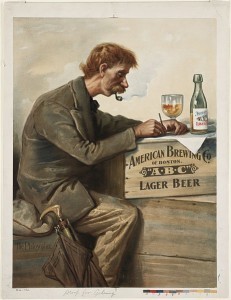 Tourists are often turned away from the Café Nevo tables, as Sternholz feels they might disturb the regulars. But “a customer on whom Sternholz deigned to wait” would not always get “what he asked for, for the waiter reserved the right to edit all orders. He gave his customers what they needed, not what they wanted.”
Tourists are often turned away from the Café Nevo tables, as Sternholz feels they might disturb the regulars. But “a customer on whom Sternholz deigned to wait” would not always get “what he asked for, for the waiter reserved the right to edit all orders. He gave his customers what they needed, not what they wanted.”
The café serves as just the center of this wondrous stage. Rogan’s novel takes us into the lives of its regular customers one by one. We meet a cabinet minister with secret real estate deals in the West Bank; a celebrity prostitute who only takes on Jewish clients and ends up pregnant by one of them; a disillusioned kibbutznik who walked away from his Israeli army service, upsetting not only his IDF general father but the entire kibbutz; a young painter who sets up her studio on Sheinkin when that street was still affordable; a famous Israeli author at odds with his Palestinian collaborator on an anthology; and the author’s estranged wife, who has a casual affair with that same Palestinian.
Sternholz doesn’t hesitate to sit down with his customers, listening to their life stories and offering solutions to their problems. Frequently he tries to kick them out of the café, to get on with their lives. As one of his regulars observes, “He was always telling customers, ‘Go home, get a job, get out of here.’ Sometimes they went, but they never stayed away. Whatever changes, growth, or petrification took place in their outside lives, they kept on coming back, as if Nevo were their spawning or their burial ground.”
Tel Aviv’s legendary Café Kassit
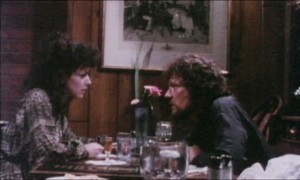 Rogan admits that the Café Nevo of her novel was modeled on Tel Aviv’s legendary Café Kassit, which was also located on Dizengoff Street. An Israeli documentary a few years ago featured Cafe Kassit, which for five decades served as a home and meeting place for the best artists in Israel. According to an article in Haaretz about the film, the cafe “helped Hebrew creativity flourish thanks to a constant flow of alcohol, food and regular or incidental muses.”
Rogan admits that the Café Nevo of her novel was modeled on Tel Aviv’s legendary Café Kassit, which was also located on Dizengoff Street. An Israeli documentary a few years ago featured Cafe Kassit, which for five decades served as a home and meeting place for the best artists in Israel. According to an article in Haaretz about the film, the cafe “helped Hebrew creativity flourish thanks to a constant flow of alcohol, food and regular or incidental muses.”
As Rogan adds on her blog, “If a missile had struck the cafe on a Friday afternoon, Israeli culture would have been pulverized.”
“My café was modeled on Kassit, not the thing itself, which could not have been encompassed in a novel; but it was also a tribute to an institution I’d thought would last forever,” Rogan writes. “But Kassit was gone, long gone. It existed only in the memories of its patrons…and, in a way, between the pages of my novel, where its fractious customers are forever presided over the café’s tyrannical waiter and secret owner, Emmanuel Yehoshua Sternholz.”
Coffee culture
Café Nevo, the book, transports readers to Café Nevo, a coffee house that was trendy long before there was a trend to visit gourmet coffee shops on a daily basis. Today Israelis flock to the local Aroma, Arcaffe, and Café Café chains and drink their espressos, their café hafuch, and their simple, instant nescafe, without worrying whether a jealous and exacting waiter will refuse to take their orders.
As for me, I will finish my cappuccino, think about the memorable Café Nevo, close my laptop and continue to my office.
Café Nevo was originally published in 1987 but has just been re-released in both e-book and paperback editions. Barbara Rogan lived in Israel for many years and was the founder and director of the Barbara Rogan Literary Agency. During that period, she served on the Board of Directors of the Jerusalem Book Fair. Her new novel, A Dangerous Fiction, will be published in July.
Originally published on The Times of Israel.”
CAFE NEVO is available on Amazon or B&N or your favorite online bookseller.
BREAKING NEWS: If you’re on Twitter, let’s make a date! I’m appearing on #LitChat this Friday, Sept. 6, between 4-5, to talk about A DANGEROUS FICTION and my checkered career as a writer/editor/literary agent.
Don’t know about you, but audio books are as essential to my car as gas. I wouldn’t get much cooking done without them, either. So I’m delighted to announce that A DANGEROUS FICTION is now available as an audio book, just issued by Audible.com. I understand that you can get it free if you join the service.
August 25, 2013
What To Do Once You’ve “Finished” Your Novel
 Send to Kindle
Send to Kindle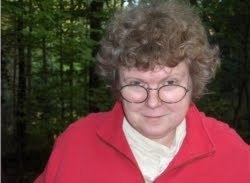 Every once in a while, I come across a blog post so informative that I just need to share it. Jo Bourne, for those of you who don’t already know her, is a critically acclaimed writer of historical fiction, including THE BLACK HAWK and THE SPYMASTER’S LADY. She’s also one of the smartest people about the craft of writing I’ve ever met. We are old friends from the Compuserve Book and Author forum, where we both serve as section leaders, and over the years I’ve found myself savoring (and quoting) much of her writing advice. This time, with her kind permission, I am reprinting an entire blog post. I hope you’ll enjoy it, and check out her blog for yourself. If you’re a writer, you’ll thank me.
Every once in a while, I come across a blog post so informative that I just need to share it. Jo Bourne, for those of you who don’t already know her, is a critically acclaimed writer of historical fiction, including THE BLACK HAWK and THE SPYMASTER’S LADY. She’s also one of the smartest people about the craft of writing I’ve ever met. We are old friends from the Compuserve Book and Author forum, where we both serve as section leaders, and over the years I’ve found myself savoring (and quoting) much of her writing advice. This time, with her kind permission, I am reprinting an entire blog post. I hope you’ll enjoy it, and check out her blog for yourself. If you’re a writer, you’ll thank me.
Here, with no further ado, is Jo:
“Congratulations on finishing your manuscript.
Woot woot.
Go celebrate.
We’ll wait.

… All through with dancing and whooping it up?
Now there are a few necessary steps to take to get from here to publication.

I. Get Crits
What: Turn some chapters of your manuscript over to harsh, knowledgeable critters. Listen to what they say. You need critters who haven’t been with you every step of the way as you wrote. Critters who are not your family or friends.
This is not putting a saucer of milk out for the tabby. This is wrapping yourself in raw meat and stepping into the lion’s cage.
 How: There’s a Writer’s Workshop in the Books and Writer’s Forum. Here. Absolute Write, here has a ‘Share Your Work’ section. Writer’s Forum here has a Writers’ Workshop.
How: There’s a Writer’s Workshop in the Books and Writer’s Forum. Here. Absolute Write, here has a ‘Share Your Work’ section. Writer’s Forum here has a Writers’ Workshop.
If you are writing genre, there are probably specialized sites for writers of your genre.
Why: Intelligent criticism of your work will help you write better and will prepare you to edit your manuscript.

II. Let the manuscript rest
What: Put the work away for as long as you can. Six weeks. Three months. Six months.
(You spend this time working on the next ms and critting other folks’ manuscripts, which is an excellent way to improve your own writing skills.)
How: Print it out and put it in a locked drawer in the bottom of your desk. Put all the work in a folder named “Open in January.
Why: This lets you look at your own work with a critical editorial eye. It gives you distance.
III. Learn how publishing works
What: Spend a solid 40 hours studying the publishing industry.
How: Start out by Googling everything you can find on the subject. Then drop into places full of knowledgeable folks and ask questions.
Why: If you were going to (a) take a job in Thailand for a year or (b) go to State Aggie to study animal husbandry or (c) work for Avis Rent-a-car, you’d do that much research about (a) the country, (b) the university or (c) the business.
Why would you go into writing with less preparation?
III. Learn about agents

What: Start making a spread sheet of agents who work in your field. See who they represent. See who they sell to. See what kind of deals they’re making. Find out what folks say about them.
If they have an on-line presence, get a feel for who they are.
How: Google. Look at the acks in the front of books similar to your own writing. Publisher’s Lunch and Publisher’s Marketplace.
Why: That’s the list you will query, when you query, if you decide you want an agent. And after all, you have some time while your manuscript is resting.
IV. Revise
What: When the manuscript has aged like, y’know, fine wine … take it out of hiding and read it over.
Now you will revise. Now you see what’s wrong.
How: Read and correct as if someone else had written it.
Why: Because, unless you have indeed done this, the manuscript is not as good as you can make it.
What: Beta readers take an entire manuscript that is ready for submission and crit it. Beta readers, if possible, have never seen the manuscript before.
How: Find them by doing beta reads for others. Find them by making friends in writers forums. Pay them in chocolate.
Why: Because they will tell you if the whole thing works. They’ll point out illogical story lines. They’ll improve the manuscript.
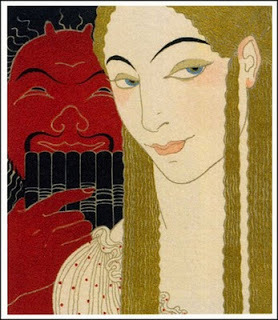 VI. Re-revise in light of the Beta read
VI. Re-revise in light of the Beta read
’nuff said.
VII. Get an agent … or not
Three months have passed since you declared your manuscript finished.
You will have read 10,000 words arguing Indie/Big Press/Small Press.
You’ll have the best manuscript you can write in one hand and a significant bit of WIP in the other.
Now you make this decision.
Many thanks to Jo for permission to reprint this post. If you appreciate her thoughts, you know the best way to thank a writer, don’t you?
Speaking of which, I’ve just learned that my new book, A DANGEROUS FICTION, has just made one of Amazon’s top 100 bestseller lists recently, the one for thrillers with female sleuths. So woot woot!, as Jo says! Recently there was a wonderful review by Joan Baum in Dan’s Papers and a couple of fun interviews, one by My Bookish Ways and one by writer Sara Bowers, and there’s more to come.
The past few weeks since launch have been quite a whirl. In fact, A DANGEROUS FICTION, worn out from the rigors of self-promotion, was recently spotted taking a bit of well-earned R&R.
August 16, 2013
Completing the Circle: From Idea to Book to Audience
 Send to Kindle
Send to Kindle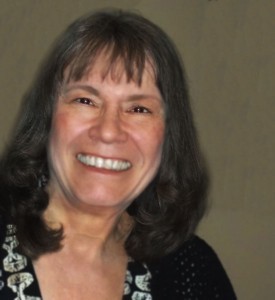 If you’ve ever gone to a writers’ conference, chances are you’ve met Elizabeth Lyons. As the author of half a dozen widely-read guides to the craft and business of writing, including The Sell Your Novel Took Kit: Everything You Need to Know About Queries, Synopses, Marketing, and Breaking In and Nonfiction Book Proposals Anybody Can Write: How to Get a Contract and Advance Before Writing Your Book, she is in great demand as a workshop leader and presenter. I had the pleasure of getting to know her at the Surrey International Writers’ Conference near Vancouver, where we were both presenters, and having many interests and pursuits in common, we’ve stayed in touch and followed each other’s careers ever since.
If you’ve ever gone to a writers’ conference, chances are you’ve met Elizabeth Lyons. As the author of half a dozen widely-read guides to the craft and business of writing, including The Sell Your Novel Took Kit: Everything You Need to Know About Queries, Synopses, Marketing, and Breaking In and Nonfiction Book Proposals Anybody Can Write: How to Get a Contract and Advance Before Writing Your Book, she is in great demand as a workshop leader and presenter. I had the pleasure of getting to know her at the Surrey International Writers’ Conference near Vancouver, where we were both presenters, and having many interests and pursuits in common, we’ve stayed in touch and followed each other’s careers ever since.
Many of her books are about breaking into the publishing market. As a freelance editor, she works hard to find agents for her editing clients. Her own books have been published by Perigree/Penguin. So I was surprised to hear from Elizabeth recently that she’d self-published her latest book, WRITING SUBTEXT. In this interview, Elizabeth talks about why she made the switch. She also has some really smart, sensible advice for writers contemplating their options.
BR: After a career spent helping other writers get published, and having been commercially published yourself, you have now taken the plunge into self-publishing. What led you to that decision?
EL: Actually, self-publishing is a homecoming. In 1980, I published my first book, Mabel: The Story of One Midwife, about a Ghana-born woman who “caught” my two children when I was doing the baby boom in Corvallis, Oregon. Handling all aspects of the book—interviewing, writing, editing, book production, and promotion gave me the publishing bug. It’s immensely satisfying to make all the decisions, feel all the responsibility, and earn all the rewards—or lack thereof.
No doubt, having a book accepted by a publisher is heady. When my agent, Meredith Bernstein, called with a four-book contract for writing books from Perigee/Penguin, I thought I had “arrived.”
“For everything there is a season.” When friends began “going indie,” with their e-books and POD (print on demand) books, they became my Sirens, calling me back to my roots.
BR : Many aspiring writers imagine doing what you’ve done, publishing multiple books with a major house like Penguin, as the height of aspiration. Why change a good thing?
EL: My editors at Penguin were and are highly skilled and lovely people. Yet, I’ve always been uncomfortable with corporate publishing policies that put most books on a conveyer belt. Most have a short life. Others, like my own, become slow backlist sellers.
While publishers don’t make giant profits, except from the mega bestselling authors, the standard publishing contract sucks. They are not written for fairness; they’re rigged for the publisher—in money and in rights.
The royalty in the contract is seldom what one receives. Almost all books are heavily discounted pushing the royalty rate to 5% of retail or even less. That’s 64 cents on a $14.95 paperback, subtracting my agent’s 15%. Publishers don’t promote non-best-selling books, and bookstores can’t possibly have midlist instructional books that span decades taking up shelf space.
I am grateful that I had that experience. I gained prestige and support for my teaching and editing work. My best publishing experience, however, was with Blue Heron Publishing, my first publisher. The owners, Linny and Dennis Stovall, nurtured writers and their careers and their publishing contract was modeled after one recommended by the National Writers Union.
BR: What have you learned from your venture into self-publishing that might be helpful to others contemplating that route?
EL: With “Writing Subtext,” my first booklet in a new series, I feel the weight of responsibility, which I’m also happy to have. I’m hyper-aware of accuracy, quality of content, and proofreading. That’s a good thing. I rely upon my critique group’s suggestions and corrections, perhaps even more so than in the past.
As I learned with my first book in 1980, there is a daunting number of skills to master when you DIY—“do it yourself,” including knowing when to job something out. I turned book cover design and digital formatting over to others who do those tasks well. With just a few hiccups requiring advice, I was able to upload my digital files and cover image files to Amazon, Barnes & Noble, and Kobo, for sale as e-books and to Amazon’s CreateSpace for print-on-demand.
 The big pink elephant in the room for all writers who publish is promotion—reaching the targeted audience. If a writer is content with selling (or giving away) books to a circle of friends or family, that’s easy. But if a writer wants to build a name and following, and even make a part-time or full-time living, then book promotion skills will require as much time as writing and revising the book, and maybe more. Writers with money can hire publicists, and these days that means someone who knows how to use the Internet for book promotion in addition to more traditional publicity.
The big pink elephant in the room for all writers who publish is promotion—reaching the targeted audience. If a writer is content with selling (or giving away) books to a circle of friends or family, that’s easy. But if a writer wants to build a name and following, and even make a part-time or full-time living, then book promotion skills will require as much time as writing and revising the book, and maybe more. Writers with money can hire publicists, and these days that means someone who knows how to use the Internet for book promotion in addition to more traditional publicity.
BR: If an aspiring writer asked for your advice on whether to self-publish or to seek an agent and try to get published commercially, what would you answer and why? Would your advice differ for fiction and non-fiction writers?
EL: My answer is the same for fiction or nonfiction writers: What is your dream? Most writers I know, and who come to me for editing, would like to see their books published in a traditional way, whether with a large publisher or a small press. I call this Plan A. The possibility of acceptance is slim. My job, however, is to support, help, and encourage any writer with a Plan A dream. Some do succeed. Realistically, novelists (and memoir writers) typically underestimate the amount of revision needed to reach a polished and professional book. Often it will be a 3rd or 4th novel that will be well enough written to succeed with Plan A.
Writers of other forms of nonfiction may reach the high bar of outstanding writing and a unique book that contributes to the literature. However, to fulfill Plan A, these writers face expectations of a strong author platform. Platform refers to how broadly a writer is known and whether he or she can guarantee strong sales through ambitious actions such as speeches, workshops, interviews, book signings, blogging, and other Internet-related promotion. Most nonfiction book writers either have to stop marketing and build that platform or move to Plan B.
Plan B recalibrates the GPS to a small, specialty, or regional press. For instance, I’ve had one editing client whose novel was published by an LGBT press. A health and medical press published a client’s nonfiction book. But all too many unpublished writers receive offers of publication from companies that are essentially print-on-demand publishers who, like the vanity publishers of old, make the writer feel as if the book is “acquired.” I always caution about these offers because there may be smoke and mirrors. In these situations, the writer can self-publish with more rewards in all ways.
Plan C is self-publishing. The long-ago stigma over “vanity publishing” is mostly gone. Producing a book with new technologies is now easy and inexpensive. For some writers, Plan C is their Plan A.
I’ve always believed that all writers deserve to complete the circle—from idea to book to audience.
BR: Positing a reasonable facility for writing, what other abilities does a writer need to make a success of self-publishing?
EL: Every self-published writer has to decide how to quantify or qualify success. I’ve worked with writers for whom a dozen copies given to friends and family constitutes success. Memoir writers, for instance, may be writing to leave a legacy as well as to reach other people who have experienced something similar to what they have.
When a book is well-written, it stands a chance of word-of-mouth recommendation, which is the most potent form of sales. Readers buy books that are recommended and books written by authors they have heard of. For the self-published author, there is typically no access to distribution, to bookstores, beyond being listed or having a page in an online bookstore. The good news is that online book sales continue to expand.
Writers seeking a large audience must devote regular time to promotion, and to the degree the writer is comfortable, learning the ropes of the Internet, and pursuing opportunities for talks, book fairs, and any face-to-face sales.
I should have said earlier that most self-published books could have benefited from more development and revision. And everyone who self-publishes should seek professional line editing or memorize The Chicago Manual of Style. I also recommend asking three eagle-eye, grammar- and punctuation- smart friends to do final proofreading.
BR: The e-book revolution has already changed publishing profoundly, in part by leveling the distribution playing field for self-publishers. Would you venture an informed guess on the future of publishing as we know it?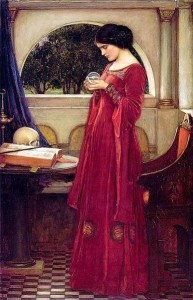
EL: People will continue to buy books for their e-readers or tablets, in ever-greater numbers. Instant gratification, the impulse buy, is not only going to increase readers but it favors the self-publisher. Our price points are typically lower, much lower, than traditional publishers. In that sense we are more competitive.
Many types of books are not presently suited for electronic format, although that hurdle is sure to be overcome. Even so, I can’t envision books featuring art and photography, for instance, offering sustained pleasure in any other form but paper. Any book that invites consideration, a chance to grasp a whole, to flip pages back and forth should if not will be preferred in paper.
Yet, my opinions may be a function of living six decades plus. When books owned in most households are few, libraries are Red Box outlets, or an aisle of Office Depot, the mega conglomerate publishing industry may no longer exist as it is.
BR: What is your new book about, and where can readers find it?
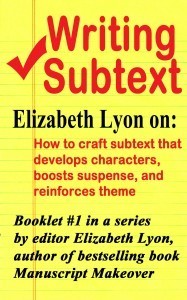 EL: My newest work is “Writing Subtext,” a booklet of 50 pages available in paper at CreateSpace/Amazon and as an e-book for Kindle, Nook, and Kobo. “Writing Subtext” is the first booklet in a series that features one technique or topic at a time. Subtext is a subtle, often confusing concept and technique. Writing it, developing it in revision, makes all the difference in boosting suspense, deepening characterization, and supporting theme. I consider it one of the “super techniques.”
EL: My newest work is “Writing Subtext,” a booklet of 50 pages available in paper at CreateSpace/Amazon and as an e-book for Kindle, Nook, and Kobo. “Writing Subtext” is the first booklet in a series that features one technique or topic at a time. Subtext is a subtle, often confusing concept and technique. Writing it, developing it in revision, makes all the difference in boosting suspense, deepening characterization, and supporting theme. I consider it one of the “super techniques.”
My next booklet will be “Crafting Titles.” On first blush, choosing a title for a book seems easy. I’ve seldom had an editing client or writing friend who hasn’t struggled to find the best title. So much goes into the choice.
Thanks so much for a really informative interview, Elizabeth. With so much hyperbole on both sides of the publish/self-publish divide, it’s a pleasure hearing and sharing your balanced take on the topic. Writers looking for a first-rate editor can contact Elizabeth through her website.
If you enjoyed this interview and want more like it, please subscribe through the link on the top right. Lately In Cold Ink has been overrun with news about my new release with Viking Books, A DANGEROUS FICTION, and I guess that’s forgivable, seeing as my new books come around as often as cicadas. But as you can see, I’m slowly getting back to my usual subjects: writing and publishing.
That said, I do want to thank Book Page for its wonderful review of A DANGEROUS FICTION, which they pronounced “ a thoroughly entertaining and engaging mystery,” and to Zan Marie Steadham for the interview on her engaging blog. I f you’re looking for little frisson in the last hot days of summer, I hope you’ll give it a read.
August 6, 2013
Launching a Novel, Then and Now
 Send to Kindle
Send to KindleLast week my new novel, A DANGEROUS FICTION, was published by Viking Books. Exactly ten years ago, Simon & Schuster came out with HINDSIGHT. The contrast in these experiences, from this writer’s perspective, is astonishing.
I’m not talking about the difference between the publishers. Each book launch is a unique experience, depending on the team members. I’m talking about the difference ten years has made to the publishing scene. HINDSIGHT came out before the explosive spread of social media. Facebook, Goodreads and Twitter didn’t exist. Ebooks didn’t exist. Amazon was just an online purveyor of print books. Writers didn’t blog; few even had websites. There was no way for readers to contact writers except through letters sent via their publishers; nor could writers reach out directly to readers. The only time I ever met my readers was at personal appearances, book signings and the like. The only reviews were newspaper and magazine reviews, which took weeks, even months to appear. Once the book was published, it was totally out of the writer’s hands. Consequently, the period immediately following a book’s publication was a curiously barren one, empty-nesthood for writers. There was nothing to do but sit and wait for print reviews to trickle in, or not.
What a difference ten years has made! The first reviews of A DANGEROUS FICTION came out before pub date—not just in PW, Library Journal and Booklist, which review for the trade, but also on popular blogs and sites like Goodreads. On pub date there was an avalanche of dammed-up reviews, followed throughout the week by a steady stream as more people read the book and blogged about it. Dozens of readers contacted me directly through email, twitter, and comments on my blog. Others posted reader reviews on Goodreads and Amazon. The feedback was immediate—and, I will add, deeply encouraging. I can’t share all the reviews in full here, (much as my ego would love that!) for copyright reasons and also because really, who but a mother would want to read every word of every review of mine? Instead I have taken brief excerpts from all the reviews I’ve seen so far and compiled them here to share with you. If you’ve seen any others, do let me know. Many thanks to the authors of these reviews for spreading the word.
I know writers who claim they never read their reviews, and I’m sure some of them are telling the truth. I’m not of that camp. If someone has taken the time to read my book, think about it and write a review, I want to hear what they have to say.
So here are the reviews, along with a few pictures from the events surrounding the book launch. Speaking of which, I have a reading in NYC at the Mysterious Bookshop, 58 Warren St. NY Wed. Aug. 7 at 6 PM. Do come if you’re in the area. You don’t want me reading to empty chairs and answering my own questions, do you?
“Required Reading: A glamorous New York literary agent has a lot to fear — and not just from really bad novels. In Rogan’s thriller, uber-agent Jo Donovan finds members of her uptown inner circle brutally murdered shortly after she rejects a manuscript. But things may get worse: She is certain the detective sent by the NYPD is not New York’s finest. In fact, he’s her ex-boyfriend. You might want to lock your door.” —New York Post
“Rogan does a masterful job of juggling the mounting suspense with a full-bodied portrait of New York literary life and Jo’s complex backstory as the widow of a major novelist in the Norman Mailer/Philip Roth mold. The fresh setting, the tricky plot, and the strong characterizations make “A Dangerous Fiction” one of the outstanding mysteries of 2013.” —- CT News http://blog.ctnews.com/meyers/2013/07/29/a-dangerous-fiction-stalking-murder-in-manhattan/
“VERDICT: This literary mystery veers back and forth between insider-gossip tone …and genuine terror at warp speed, fulfilling many of the requirements for a perfect beach read.” —Library Journal http://reviews.libraryjournal.com/2013/05/books/genre-fiction/mystery/mystery-reviews-may-1-2013/
“You won’t get much argument from anyone (including writers) that writers are crazy — but the writer stalking New York literary agent Jo Donovan seems especially bent on harm….Rogan does give readers a lot of insider publishing tidbits and provides a very likeable and believable protagonist in Jo.” —Cleveland Plain Dealer http://www.cleveland.com/books/index.ssf/2013/07/karin_slaughter_mike_lawson_an.html
“Boasting an exciting pace, well-constructed scenes, and inside information about the publishing word, this engaging mystery will attract readers of P. D. James’ similar Original Sin (1995).”—Booklist
“Someone in the New York publishing world is targeting literary agent Jo Donovan, the appealing, empathetic narrator of this clever mystery from Rogan (Suspicion), herself a former book editor and agent. “ —Publishers Weekly http://www.publishersweekly.com/978-0-670-02650-0
“If you love a tautly-spun web of deceit and revenge, put A Dangerous Fiction by Barbara Rogan at the top of your summer reading list….Rogan’s book takes you by surprise as she deftly reveals the publishing world, sprinkles around red herrings, and makes you question the secrets you may have forgotten from your own past.”– Dolce Dolce http://www.dolcedolce.com/?tag=a-dangerous-fiction-by-barbara-rogan-review
“Barbara Rogan (Hindsight; Suspicion) provides a fascinating glimpse into the New York publishing world…Fast-paced and witty, full of deftly drawn characters, Rogan’s literary mystery introduces a tough but compassionate heroine and an entertaining new series.” —Shelf Awareness: http://www.shelf-awareness.com/readers-issue.html?issue=218
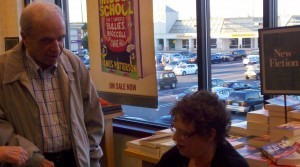 “I read a lot of great books, but this one is outstanding! I resented every moment I had to be away from it—and I read it from cover to cover today….A Dangerous Fiction will get my vote for best mystery novel next year.”—Meritorious Mysteries, http://mysteryheel.blogspot.com/
“I read a lot of great books, but this one is outstanding! I resented every moment I had to be away from it—and I read it from cover to cover today….A Dangerous Fiction will get my vote for best mystery novel next year.”—Meritorious Mysteries, http://mysteryheel.blogspot.com/
“We love this new series from Barbara Rogan—how can you go wrong with a literary agent turned PI? Jo Donovan is one of the most successful literary agents in New York City, and she’s being stalked by one of her clients. When her stalker starts to harass her other clients, Jo finally turns to the police—where an ex-lover is now an NYPD detective. This is one you won’t want to put down.”—Shelf Pleasure http://www.shelfpleasure.com/news-new-releases-7-23-11/
“This story had me turning pages at a fast and furious pace. I finished last night and could hardly wait to start spreading the good word for A Dangerous Fiction… If you’re searching for a smart and snappy summer read, this is the one to watch for, folks.” — http://livingreadgirl.blogspot.com/2013/07/barbara-rogan-opens-page-to-dangerous.html
“I loved getting behind the scenes of the publishing world, from the agency’s monthly ‘slush-pile’ meeting where submitted manuscripts are waded through (and mostly discarded), to glittering book launch parties.” —Crime Fiction Lover http://www.crimefictionlover.com/2013/07/a-dangerous-fiction/
“It’s cliched to say ‘I couldn’t put it down!’, but that’s how I felt about A Dangerous Fiction. Rogan brings an insider’s keen view, pulling the reader into the New York publishing milieu with all of its jealousies, intrigue, excitement and larger-than-life personalities. At the heart of the story is a woman’s need to uncover the truths about her own life, even as she’s the target of malevolent foes she can’t identify. Danger, suspense, romance and the deep bonds of friendship–A Dangerous Fiction has it all.” —Darlene Marshall http://darlenemarshall.blogspot.com/2013/07/review-dangerous-fiction.html
“A Dangerous Fiction is a witty and intense mystery full of twists and turns and a few omg moments. …One minute I was laughing and the next I was crying….I recommend this book to everyone, but especially those of you who are avid readers, writers, or interested in the publishing industry.”—It’s a Book Life http://itisabooklife.blogspot.com/2013/08/review-dangerous-fiction-by-barbara.html
“Sometimes, but not often, you open a book, read the first few pages, and know without a doubt that you will thoroughly enjoy a book. A Dangerous Fiction by Barbara Rogan was just that sort of book.” —The Picky Girl http://www.thepickygirl.com/?p=3134
“There is behind-the-scenes quality to the book that is fun and informative. The thriller aspect of the novel had me jumping at noises in my house…This is a good, solid mystery with great characters and I hope there is a sequel in the works.” —Shari’s Book Notes http://sharisbooknotes.blogspot.com/2013/08/a-dangerous-fiction-by-barbara-rogan.html
“Smashing new thriller…Every aspect of A Dangerous Fiction works together and works so wonderfully well. Rogan’s experience as a literary agent provides a fascinating look at how the business works….marvelously realized….Just make certain you have time set aside when you start A Dangerous Fiction because this fast-paced novel is the kind you don’t want to put down until the last page is read.”— Lynne’s Book Notes http://lynne-booknotes.blogspot.com/
“Readers who take this one to the beach should find themselves engaged, entertained, and enlightened.”—Reviewing the Evidence, http://www.reviewingtheevidence.com/review.html?id=9753
“I have never read a novel from cover to cover at one sitting in my life…until last night.”—Donna Rubino blogspot http://www.donnarubino.com/recent-reads-2/#comment-42
If you’ve read A DANGEROUS FICTION and you’re waiting for the next Jo Donovan story, be assured there’s one on the way. In the meantime, you might enjoy one of my other books. Five of them have been reissued as ebooks and paperbacks, including SUSPICION, a mystery and a ghost story combined, and CAFE NEVO, my family’s favorite and a book that earned praise from Alan Sillitoe, Alice Hoffman and Madeleine L’Engle.
July 25, 2013
A DANGEROUS FICTION is out today!
 Send to Kindle
Send to Kindle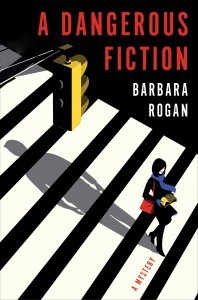 It’s been a long time a’coming, friends, but A DANGEROUS FICTION is out at last!
It’s been a long time a’coming, friends, but A DANGEROUS FICTION is out at last!
In the past few days, there have been a bunch of wonderful reviews from bloggers and online book-review sites. I won’t cite them all right now, because I have to run, but there was one that particularly touched me and got to the heart of the book as I saw it and hoped it would be seen. That’s a review by blogger Lynne Perednia, and you can read it here if you like.
I promised you a surprise, and here it is: the prologue and first chapter of A DANGEROUS FICTION, available on line. If you like what you read, there’s a “buy” link on the site. You can also purchase the book from Amazon, B&N, Indiebound, or your favorite local bookstore.
Would love to post photos of readers with the book, so if you do get a copy, please send me a picture of you holding it, or your dog reading it, or whatever pose you like (Anthony Weiner-style poses excepted), and I’ll share it on the blog. You can reach me at barbararogan at msn dot com.
Happy reading!
July 23, 2013
T Minus Two and Counting!
 Send to Kindle
Send to KindleMost of my posts on In Cold Ink focus on writing and publishing, with lots of advice and not a few opinions drawn from my own checkered history as a former agent and editor. Today, though, I’m wearing my writer’s hat. In two days, A DANGEROUS FICTION (my first new novel in nine years!) is coming out with Viking Books. I need to share some news about that. If you’re allergic to anything resembling self-promotion, turn away now; I won’t hold it against you. But if you’re interested in learning about this huge event in my life, then read on, McDuff!
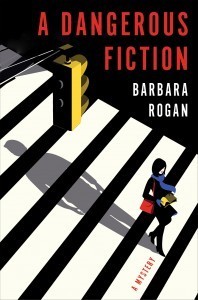 Viking has done a beautiful job packaging the book. I couldn’t have imagined a more perfect cover or one that better captures the spirit of the story. The pre-publication reviews have been wonderful. From Library Journal: “This literary mystery veers back and forth between insider-gossip tone…and genuine terror at warp speed, fulfilling many of the requirements for a perfect beach read.” From Booklist: “Boasting an exciting pace, well-constructed scenes, and inside information about the publishing world, this engaging mystery will attract readers of P. D. James’ similar Original Sin.” Publishers Weekly loved “literary agent Jo Donovan, the appealing, empathetic narrator of this clever mystery from Rogan (Suspicion), herself a former book editor and agent.” PW also interviewed me.
Viking has done a beautiful job packaging the book. I couldn’t have imagined a more perfect cover or one that better captures the spirit of the story. The pre-publication reviews have been wonderful. From Library Journal: “This literary mystery veers back and forth between insider-gossip tone…and genuine terror at warp speed, fulfilling many of the requirements for a perfect beach read.” From Booklist: “Boasting an exciting pace, well-constructed scenes, and inside information about the publishing world, this engaging mystery will attract readers of P. D. James’ similar Original Sin.” Publishers Weekly loved “literary agent Jo Donovan, the appealing, empathetic narrator of this clever mystery from Rogan (Suspicion), herself a former book editor and agent.” PW also interviewed me.
I’ll be doing a few readings and signings in the New York vicinity. I love meeting readers. It’s one of the best part of the whole book-writing enterprise, especially for slow writers like me who spend years at a time locked in our caves. I hope you’ll come out and say hi if you’re going to be in the area.
Monday, July 29, 7PM:
Barnes & Noble
Old Country Rd., Carle Place, NY
Wednesday, Aug. 7 , 6-8 PM
The Mysterious Bookshop, 58 Warren St. New York NY
Saturday, Aug. 17 (Aug.. 18 raindate) 3-5 PN
Berken residence, 60 Bayview Dr. East, Sag Harbor, NY
For those of you outside the New York area, I have a special offer. If your bookclub chooses A DANGEROUS FICTION or any of my other novels, for that matter, I’ll drop in on your meeting via Skype or phone. Of course, visiting that way means I’ll miss the refreshments, but one can’t have everything. Contact me to make arrangements,
Right about now I imagine you’re saying to yourself, “I’d love to help Barbara launch her book successfully, but her fancy New York publisher seems to have things well in hand; and besides, what could I possibly do to help?” (If you’re not asking yourself that question, why is that, exactly?) But in fact, there’s a great deal you can do to help, not just me, but your favorite authors whoever they may be. Here are a few things readers can do:
1. Buy their books. Doesn’t matter what format. Writers live and die by their sales.
2. Write a review and post it on Amazon and your favorite social media sites. Tell your friends, too. Word of mouth sells books. It always did, but the internet is a huge multiplier of that process. I know writing reviews takes time, that precious commodity, but it’s one of the most helpful things you can do for a writer. Reviews needn’t be long, literary masterpieces. Just think of what you’d say to a friend who asked about the book, and write that.
Writers read those reviews, btw, and they can be wonderfully encouraging. I found this new review posted for “Rowing in Eden” from a reader named “Kheseygirl,” which I quote here in its entirety: “I love, love, love Barbara Rogan’s writing. I hope her new book, due this summer, tips that balance for her in getting the kind of widespread readership her writing so deserves.” Thanks, Kheseygirl, whoever you are. You totally made my day!
3. Books make great gifts. Not only are you doing something nice for the recipient, you’re supporting your favorite writer.
4. Look for other books by the author. I’ve got five other books that were re-issued this year as paperbacks and ebooks, and if you liked A DANGEROUS FICTION, I’m pretty sure you’ll like them too.
I have a major surprise that I’ll be sharing in just a couple of days, so if you haven’t already, you might want to subscribe to the blog via a link on the right. Thanks for reading!
July 8, 2013
Game of Words: Writing Lessons From TV
 Send to Kindle
Send to Kindle
My name is Barbara, and I’m an addict.
I’m addicted to Game of Thrones. That’s not all; I’m also hooked on Bates Motel, and recently I kicked Downton Abbey, not through any effort or willpower of my own, but because the supply dried up.
The Game of Thrones trouble began with the George R. R. Martin books. I was writing A Dangerous Fiction at the time, and was in search of a bit of light reading as a palette cleanser. I started reading the first book in the series, and several million pages later, I looked up blearily from the last and realized that three weeks had passed and I hadn’t done a lick of work. The TV series only made the situation worse. I started out watching each new episode on Sunday nights. Before long I was mainlining repeat showings two or three times a week.
I’m not proud of this. When I was younger, I took an elitist view of television. I owned a set, of course, because not to would seem like snobbery, and besides, TVs make great babysitters. But I rarely watched it. I am a writer; I read.
I still don’t watch many shows, but those I do follow, I watch with a writer’s eye. I ask the same questions I ask when a book floors me: What makes this story so compelling, and where can I get me some?
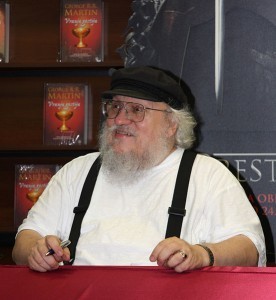 In the case of Game of Thrones, I recognized all the basic ingredients of good fiction. Great characters? Check. High stakes? The highest: life or death, honor or disgrace, the fate of kingdoms. Interesting settings? Fascinating and vividly imagined. All sterling qualities, and enough to make any story compelling, yet I felt that something more was needed to explain the three-week hole Martin’s books had blasted in my life.
In the case of Game of Thrones, I recognized all the basic ingredients of good fiction. Great characters? Check. High stakes? The highest: life or death, honor or disgrace, the fate of kingdoms. Interesting settings? Fascinating and vividly imagined. All sterling qualities, and enough to make any story compelling, yet I felt that something more was needed to explain the three-week hole Martin’s books had blasted in my life.
And then, as I watched a recent episode, the answer finally dawned on me. The scene was one in which Cersei visits Tyrion in his much diminished quarters to suss out what he plans to tell their father. Tyrion, in turn, wants to know precisely what she’s afraid he’ll say. It’s not an action scene; there are no dragons or swordplay. Yet the scene is terrifically tense. The dialogue shows each one trying to elicit information from the other while concealing his/her own intentions and concerns. Each character had a vital agenda, and those agendas were perfectly at odds.
What I realized at that moment was that the same could be said of nearly all Martin’s scenes. The man seems incapable of framing any scene that is not full of conflict and hidden agendas. In scene after scene, his characters use manipulation, intimidation, flattery, violence, seduction and every other means of persuasion to impose their will.
I was drawn to Bates Motel by its two stars, Vera Farmiga and Freddie Highmore, who are both outstanding, but I stayed because the story wouldn’t let me leave. It sent out tentacles, first implanting questions in my mind (“What happened to Norman’s father?” is a big one), then taking its own sweet time answering them: an old writer’s trick.
And even when answers are provided, they are only as reliable as the character providing them, which in the case of Bates Motel means not at all. The unreliable narrator is a useful literary device that works because readers initially trust the narrator’s version of events. Their gradual realization that a particular narrator may be lying or deluded casts a whole different light on the story. The Remains Of the Day, Gone Girl, and Shutter Island are excellent examples. Usually the device does not work as well on film, because it’s harder to keep up the illusion when readers can see events with their own eyes instead of through the narrator’s. But Bates Motel manages it beautifully in the death of Norman’s father.
We see two versions of that death, which takes place before the start of the story. The first is Norman’s memory of discovering his father’s body. In that version, he is shocked and heartbroken, while his mother, Norma, is clearly not surprised at all; the only emotion she shows is pity for her son’s distress. Viewers are led to the supposition that she staged the accident.
Many episodes later, we see the death from Norma’s point of view. In that version, Norma casts herself as victim and protector. But since viewers know by now that this is how she justifies all the crazy things she does, they still can’t be sure about what happened and who did what. Both Norman and his mother are quite mad. He suffers from blackouts and hallucinations, while she has a major personality disorder or three. That makes them classic unreliable narrators, which allows the real narrators—the series’ writers—to play all sorts of tricks on viewers. We can’t trust anyone, and that uncertainty keeps us watching. In stories, as in music, it’s the unresolved chord that draws us onward.
Now, I’ll concede that writers are adept at justifying bad behavior in the name of art, including addictions to worse substances than popular TV. Nevertheless, I will maintain that my affliction has its beneficial side; indeed I’ll go so far as to recommend it to any writer interested in improving his or her craft.
From Game of Thrones, writers can learn to seek out our characters’ hidden agendas; to frame scenes to take maximum advantage of those conflict; and to do this not once in a while, but in every scene. Bates Motel, is a masterclass in the use of unreliable narrators and delayed gratification to enhance suspense. Lessons worth learning, I’d say, whatever the price. Besides, when I said I’m addicted to these series, I was taking poetic license. I can stop watching anytime I want to. Really I can.
Reprinted from a post on www.Bookcountry.com.

